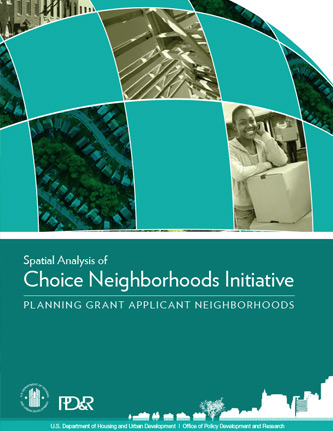
Characteristics of Choice Neighborhoods Planning Grant Applicants

The Choice Neighborhoods initiative (Choice) awards planning and implementation grants to public and private organizations to revitalize high-poverty neighborhoods containing severely distressed subsidized housing. Building from the successes and lessons learned from the HOPE VI program, Choice expands eligibility in both the pool of applicants — going beyond public housing agencies to include local government, nonprofit, and private groups — and target areas, incorporating other types of HUD-assisted housing and more of the surrounding neighborhood than did HOPE VI.
A new HUD report by Matthew F. Gebhardt of Portland State University, “Spatial Analysis of Choice Neighborhoods Initiative Planning Grant Applicant Neighborhoods,” examines the characteristics of neighborhoods applying for planning grants during the first three years of Choice to understand how local actors select and define neighborhood boundaries and determine what distinguishing characteristics, if any, exist between successful and unsuccessful applicants. The report analyzes HUD data, including data generated by a HUD-developed online mapping tool used by applicants, as well as data from the U.S. Census Bureau, including Topically Integrated Geographic Encoding and Referencing (TIGER) files and American Community Survey estimates. The data were merged using ArcGIS, from which output tables were created to assemble descriptive statistics for applicant neighborhood profiles.
Key Findings
The research outlines the housing, economic, and demographic characteristics of all Choice planning grant applicant neighborhoods for Fiscal Years 2010, 2011, and 2012. Reflecting the considerable leeway granted to applicants in defining neighborhood boundaries, no consistent patterns were observed in the physical size, population, and number of housing units of applicant neighborhoods. Much like other high-poverty, low-income neighborhoods across the country, the average applicant neighborhood demonstrates the following characteristics:
- Is mostly rental in housing tenure, has a high vacancy rate, and (especially in the Northeast and Midwest) has a housing stock with a median age of approximately 60 years.
- Has a lower median household income than its corresponding city and metropolitan area, a high unemployment rate, a poverty rate of approximately 30 percent, and a typical educational attainment of high school or below.
- Has a declining population that is younger than its corresponding city, is a majority-minority area, and is highly segregated.
By comparison, areas immediately surrounding applicant neighborhoods consistently demonstrate the following characteristics:
- Higher median incomes and lower rates of poverty and unemployment;
- Higher homeownership rates, lower vacancy rates, and newer housing stock; and
- Greater racial diversity.
Gebhardt suggests that the fact that applicant neighborhoods were consistently worse off than the neighborhoods surrounding them may indicate that they were selected either to capture spillover from revitalization already in progress or simply because they were the most distressed neighborhoods in the area.
The applicant neighborhoods that were awarded planning grants generally have higher poverty, unemployment, and vacancy rates than do unsuccessful applicant neighborhoods. More densely populated neighborhoods with higher numbers of housing units were also more likely to receive planning grants. The very largest and very smallest applicant neighborhoods were less likely to successfully secure a grant than were moderately sized neighborhoods.
Future Research
In addition to expanding the dataset to include profiles of applicants in subsequent years of Choice funding, Gebhardt recommends that future research explore how factors other than the physical, demographic, and geospatial characteristics considered in this study might distinguish successful applications from unsuccessful ones. Finally, the profiles of planning grant applicant neighborhoods provide a baseline for tracking and analysis of which neighborhoods successfully move from planning to implementation and whether Choice contributes to neighborhood revitalization.
PD&R Leadership Message Archive
International & Philanthropic Spotlight Archive
Spotlight on PD&R Data Archive
Publications
Collecting, Analyzing, and Publicizing Data on Housing Turnover
Resilience Planning: What Communities Can Do to Keep Hazards from Turning into Disasters
Cityscape: Volume 26, Number 3
Case Studies
Case Study: Former School in Charleston, South Carolina, Transformed into Affordable Housing for Seniors
Case Study: Avalon Villas Combines Affordable Housing and Services for Families in a Gentrifying Phoenix Neighborhood

The contents of this article are the views of the author(s) and do not necessarily reflect the views or policies of the U.S. Department of Housing and Urban Development or the U.S. Government.
Note: Guidance documents, except when based on statutory or regulatory authority or law, do not have the force and effect of law and are not meant to bind the public in any way. Guidance documents are intended only to provide clarity to the public regarding existing requirements under the law or agency policies.



